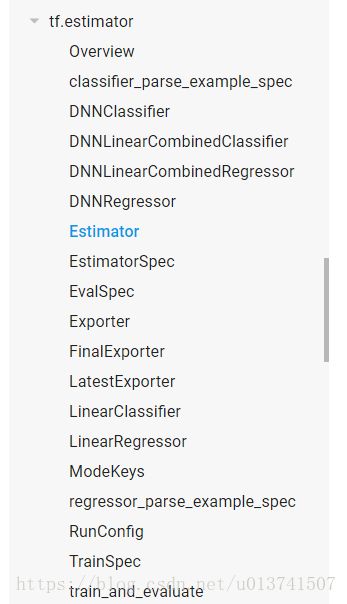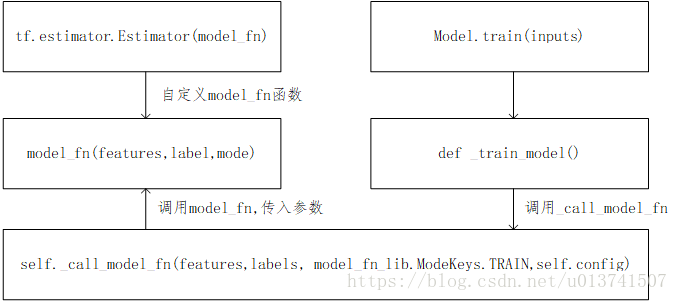Tensorflow实战——使用Estimator创建卷积神经网络
这里是LeeTioN的博客
前言
本篇文章是针对GitHub上的一个TensorFlow实例来进行源码讲解和分析
Esitmator简介
Esitmator是用来封装网络模型和参数的类,它的父类estimator(小写字母e)的其它子类有线性回归和分类等其他经典模型,而Esitmator用于构造自定义网络模型。

Estimator定义和传参方式
在Estimator中我们需要一个model_fn函数来自定义我们的网络,同时规定好features, labels和mode(可选模式,train, predition, evaluate)三个参数。
def model_fn(features, label, mode):
……
model = tf.estimator.Estimator(model_fn)model.train(input_fn, steps=num_steps)但是在model.train()函数并没有看到以上三个参数的传入,所以我就前往Tensorflow框架中的estimator.py源码看一看,在train()函数里面,调用了_train_model函数,函数中又调用了model_fn的回调函数,里面则传递了features, labels, ModeKeys等参数。
def _train_model(self, input_fn, hooks, saving_listeners):
……
estimator_spec = self._call_model_fn(
features, labels, model_fn_lib.ModeKeys.TRAIN, self.config)
……
return loss总的来说,以trian的整个流程举例,如下图所示。prediction和evaluation的过程类似。

用model_fn构建CNN
构建就是基本的常规操作了,这里主要注意到model_fn是要切换训练、预测和评估三种模式,所以三种模式下的不同操作都要写在model_fn函数里。
def conv_net(x_dict, n_classes, dropout, reuse, is_training):
with tf.variable_scope('ConvNet', reuse=reuse): # 变量共享,用于管理一个graph 中变量的名字,避免变量之间的命名冲突
x = x_dict['images']
x = tf.reshape(x, shape=[-1, 28, 28, 1])
# 4维张量[batch_size, height, width, channel]
conv1 = tf.layers.conv2d(x, 32, 5, activation=tf.nn.relu)
# 第一层卷积层 filters = 32, kernel_size = 5 ,过滤器的维度[5, 5],有32个
# [batch_size, 24, 24, 32]
# 若此时 padding = "same" 则会输出[batch_size, 28, 28, 32] 具体操作是在张量周围补0
conv1 = tf.layers.max_pooling2d(conv1, 2, 2)
# 卷积后的pooling [batch_size, 12, 12, 32]
conv2 = tf.layers.conv2d(conv1, 64, 3, activation=tf.nn.relu)
# 第二层卷积层
conv2 = tf.layers.max_pooling2d(conv2, 2, 2)
# 卷积后的pooling
fc1 = tf.contrib.layers.flatten(conv2)
# 全连接层
fc1 = tf.layers.dense(fc1, 1024)
fc1 = tf.layers.dropout(fc1, rate=dropout, training=is_training)
# dropout层
out = tf.layers.dense(fc1, n_classes)
return outdef model_fn(features, labels, mode): # ModeKey: TRAIN, EVAL, PREDICT
logits_train = conv_net(features, num_classes, dropout, reuse=False,
is_training=True)
logits_test = conv_net(features, num_classes, dropout, reuse=True,
is_training=False)
pred_classes = tf.argmax(logits_test, axis=1)
pred_probas = tf.nn.softmax(logits_test)
if mode == tf.estimator.ModeKeys.PREDICT:
return tf.estimator.EstimatorSpec(mode, predictions=pred_classes)
loss_op = tf.reduce_mean(tf.nn.sparse_softmax_cross_entropy_with_logits(
logits=logits_train, labels=tf.cast(labels, dtype=tf.int32)))
optimizer = tf.train.AdadeltaOptimizer(learning_rate=learning_rate)
train_op = optimizer.minimize(loss_op,
global_step=tf.train.get_global_step())
acc_op = tf.metrics.accuracy(labels=labels, predictions=pred_classes)
estim_specs = tf.estimator.EstimatorSpec(
mode = mode,
predictions=pred_classes,
loss=loss_op,
train_op=train_op,
eval_metric_ops={'accuracy': acc_op})
return estim_specs